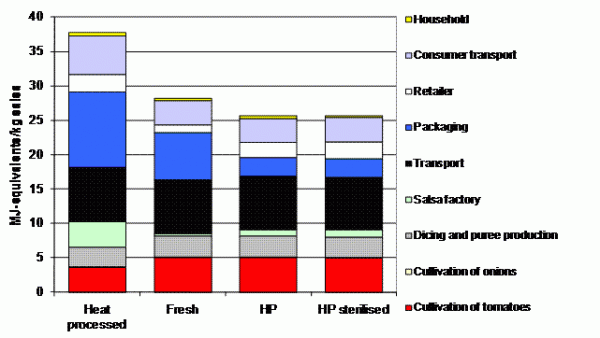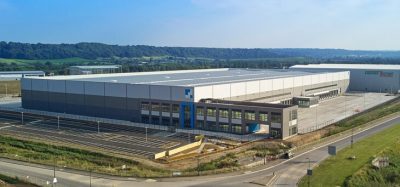Novel processing and sustainable food production – a perfect match or not?
- Like
- Digg
- Del
- Tumblr
- VKontakte
- Buffer
- Love This
- Odnoklassniki
- Meneame
- Blogger
- Amazon
- Yahoo Mail
- Gmail
- AOL
- Newsvine
- HackerNews
- Evernote
- MySpace
- Mail.ru
- Viadeo
- Line
- Comments
- Yummly
- SMS
- Viber
- Telegram
- Subscribe
- Skype
- Facebook Messenger
- Kakao
- LiveJournal
- Yammer
- Edgar
- Fintel
- Mix
- Instapaper
- Copy Link
Posted: 4 November 2010 | Ulf Sonesson, Swedish Institute for Food and Biotechnology (SIK) | No comments yet
Food is indispensible to humans. Aside from the provision of energy and nutrients, it contributes to a range of important aspects of human life such as pleasure, cultural identity and heritage. At the same time, food accounts for a significant global share of total environmental impact and resource use. It is difficult to accurately quantify this impact, but estimates show that food chains globally account for 25 – 30 per cent of greenhouse gas emissions and energy use, and food production occupies most of the available arable land. Agriculture is also the single largest user of water and has a tremendous impact on biodiversity.
Food is indispensible to humans. Aside from the provision of energy and nutrients, it contributes to a range of important aspects of human life such as pleasure, cultural identity and heritage. At the same time, food accounts for a significant global share of total environmental impact and resource use. It is difficult to accurately quantify this impact, but estimates show that food chains globally account for 25 - 30 per cent of greenhouse gas emissions and energy use, and food production occupies most of the available arable land. Agriculture is also the single largest user of water and has a tremendous impact on biodiversity.
Food is indispensible to humans. Aside from the provision of energy and nutrients, it contributes to a range of important aspects of human life such as pleasure, cultural identity and heritage. At the same time, food accounts for a significant global share of total environmental impact and resource use. It is difficult to accurately quantify this impact, but estimates show that food chains globally account for 25 – 30 per cent of greenhouse gas emissions and energy use, and food production occupies most of the available arable land. Agriculture is also the single largest user of water and has a tremendous impact on biodiversity.
Considering the global situation regarding climate change, energy and water usage as well as depletion of ecosystems, all sectors need to decrease their impact and food is no exception. The established method of assessing the environmental impact of products is Life Cycle Assessment (LCA). LCA focuses on the product and should include the whole life cycle ‘from-cradle-to-grave’. When performing an LCA, all relevant inflows (energy, material etc.) are quantified and related to the product at a certain stage in the life cycle (e.g. MJ/litre milk at the retail gate). Also included are methods to weigh together the emissions of different single substances contributing to the same environmental impact, such as in climate change where emissions of carbon dioxide, methane and nitrous oxide are transformed into the single unit ‘carbon dioxide equivalents’.
As a general rule, products of animal origin such as meat, fish and dairy have greater impact than those of vegetable origin, but there are of course exceptions. Food processing is often a smaller share of a products’ life cycle environmental impact; primary production (agriculture and fishery) generally dominates whilst the later portion of the chain (households) dominate for some products. In some cases, packaging and transport can be of importance. However, for highly processed vegetable products, processing can account for the largest share of life cycle impact. Since primary production often accounts for a large share of total impact, reduced waste in later steps is an important potential improvement. Even if food processing has a lower environmental impact for many products, how the food is processed can dramatically affect its performance; what packaging was used, preferred shelf-life and final preparation, the environmental impact of food processing is a combination of direct impact (energy- and water use, direct emissions from factories) and indirect impact (choice of packaging, shelf-life, raw material utilisation). Obviously, processing affects sensory and nutritional qualities, which in turn affect wider sustainability aspects but this is not included here, despite its importance.
Novel processing and sustainability
Novel, mild processing methods and treatments, based on physical measures, are highly promising in terms of:
» less use of energy
» less use of water
» efficient use of raw materials by better yields and less waste
» efficient use of packaging materials and avoidance of re-packing
» shelf life extension and reduction of product losses in the food chain
» less cleaning and disinfectants
» avoidance of chemical preservatives
This list shows good correspondence with important aspects mentioned in the intro – duction. Thus, novel processing technologies offer alternatives for more sustainable food products. However, it is important to consider the entire life cycle of individual food products rather than product groups because reality is too complex and food is too diverse a product group for generalisations. Moreover, many environmental aspects must be considered; sustainability is more than just energy use. Within NovelQ, LCA studies have been applied to several cases where novel processing technologies have been compared with conventional processing. One of these will be used to demonstrate the life cycle environmental performance of different technologies applied to specific products, and highlight the importance of looking at the entire systems, not just the process in isolation.
Case study example – production of tomato salsa
In this case study, conventional heat treated salsa was compared with fresh salsa and two high-pressure (HP) processed salsas, one pasteurised and one sterilised. An assortment of methods for production brought about a number of differences between the products, which are summarised below (the case study is more thoroughly described in Davis et al, 2009):
» heat treated salsa packaged in glass jars
» fresh, untreated salsa (citric acid is added) packaged in polypropylene tubs
» high pressure treated salsa packaged in polyethylene pouches
» high pressure and temperature treated salsa packaged in polyethylene pouches (sterilised)
The resulting products are slightly different in terms of freshness, storage requirement and shelf life (closed and opened, respectively). The life cycles were followed from production of agricultural inputs (raw ingredients) through processing, transportation and retail, finishing at the point of consumption in the household. The results showed that HP processing gave lower energy use (Figure 1), partly due to more energy efficient processing but more as a result of the potential to use more energy efficient packaging. The energy use by the retailer was higher for HP sterilised and heat-treated products even when they are stored at ambient temperature as compared with fresh and HP pasteurised products, which demand refrigerated storage. This is explained by the much longer storage time for HP sterilised and heat-treated products (12 months). Transportation is a significant contributor to all four product life cycles (transportation includes all transport of packaging materials, raw materials and the product up to retailing), but there are only minor differences between the products. It is also important to note that consumer transport accounts for a large part of the overall energy use; conventional salsa has a slightly higher contribution than the others because the packaging is heavier. Other differences were small and are not explained here. The environmental gains of HP against heat-treatment are reached through the combination of issues where more energy efficient processing is only one aspect.


Figure 1 Use of primary energy in the life cycle of tomato salsa products
Discussion
It is not possible to answer the question posed in the title in a single sentence. The changes in environmental impact caused by switching from conventional to novel processing arises from a combination of factors in raw material requirements (quality), utilisation (wastage), processing energy, shelf-life, packaging solutions and so on. Food products are an extremely heterogeneous group with very different ‘environmental profiles’ from a life cycle perspective, which complicates matters further. Novel processing technologies bring about very different options for processing, packaging and product quality. Hence, the environmental impact of novel processing, as well as any change in the food chain, depends on the context; how the food chain as a whole is designed and managed. Regardless of this discouraging complexity, there are good opportunities to design food chains including novel technologies, as shown in the case study example above. LCA methodology is improving and databases are being developed, making analyses less costly and time consuming. The application of LCA combined with economic assessments has been shown to be an efficient tool for improving food business from both an economic and environmental point of view.
In conclusion, novel processing tech nologies provide great opportunities to improve the sustainability of food systems by reducing energy use in processing and waste in the food chain. But it is important to consider the entire life cycle of a product when designing the process / system so as to avoid increasing environmental impact from, for example, new packaging, which comes with the technology, or overlooking benefits from options made possible with new technology. Finally, it is important to keep in mind the potential to increase product quality, both sensory and nutritional, which novel processing brings about. This might turn out to be as important more broadly than simply the environmental aspects.
References
Sonesson, U., Berlin, J. & Ziegler, F. (Eds), 2010, Environmental Assessment and Management in the Food Industry – Life cycle assessment and related approaches, Woodhead Publishing Limited, Cambridge UK
Sonesson, U., Davis, J., & Ziegler, F., 2010, Food Production and Emissions of Greenhouse Gases – An overview of climate impact of different product groups, SIK-Report 802, SIK – The Swedish Institute for Food and Biotechnology, Göteborg, Sweden
Davis, J., Moates, K G., Waldron, K W., 2009, High Pressure Processing – A step towards sustainability? Food Safety Magazine October/November









